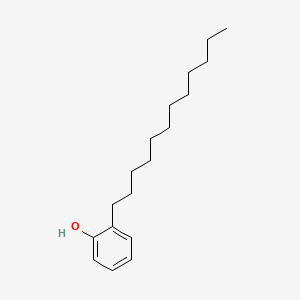D0902 | dodecylphenol
| Toxicity | Dose | Time | Species | Model | Method | Action | Positive criterion | Reference |
|---|---|---|---|---|---|---|---|---|
| MEMBRANE POTENTIAL | 3.10±1.22 | human | qHTS-HepG2 | MMP assay | decrease | IC50 | 163 | |
| MEMBRANE POTENTIAL | 3.16 | human | HepG2 | MMP assay | decrease | IC50 | 163 | |
| MEMBRANE POTENTIAL | 41.11±13.24 | rat | hepatocytes | MMP assay | decrease | IC50 | 163 | |
| Pictogram | Signal | Statements | Precautionary Statement Codes |
|---|---|---|---|
   |
Warning |
Aggregated GHS information provided by 612 companies from 8 notifications to the ECHA C&L Inventory. Each notification may be associated with multiple companies. Reported as not meeting GHS hazard criteria by 2 of 612 companies. For more detailed information, please visit ECHA C&L website Of the 7 notification(s) provided by 610 of 612 companies with hazard statement code(s): H315 (84.26%): Causes skin irritation [Warning Skin corrosion/irritation] H319 (80.16%): Causes serious eye irritation [Warning Serious eye damage/eye irritation] H361 (80.16%): Suspected of damaging fertility or the unborn child [Warning Reproductive toxicity] H400 (90.49%): Very toxic to aquatic life [Warning Hazardous to the aquatic environment, acute hazard] H410 (90.49%): Very toxic to aquatic life with long lasting effects [Warning Hazardous to the aquatic environment, long-term hazard] Information may vary between notifications depending on impurities, additives, and other factors. The percentage value in parenthesis indicates the notified classification ratio from companies that provide hazard codes. Only hazard codes with percentage values above 10% are shown. |
P201, P202, P264, P273, P280, P281, P302+P352, P305+P351+P338, P308+P313, P321, P332+P313, P337+P313, P362, P391, P405, and P501; (The corresponding statement to each P-code can be found at the GHS Classification page.) |
 |
Danger |
Aggregated GHS information provided by 39 companies from 2 notifications to the ECHA C&L Inventory. Each notification may be associated with multiple companies. H314 (97.44%): Causes severe skin burns and eye damage [Danger Skin corrosion/irritation] H412 (97.44%): Harmful to aquatic life with long lasting effects [Hazardous to the aquatic environment, long-term hazard] Information may vary between notifications depending on impurities, additives, and other factors. The percentage value in parenthesis indicates the notified classification ratio from companies that provide hazard codes. Only hazard codes with percentage values above 10% are shown. |
P260, P264, P273, P280, P301+P330+P331, P303+P361+P353, P304+P340, P305+P351+P338, P310, P321, P363, P405, and P501; (The corresponding statement to each P-code can be found at the GHS Classification page.) |
| 2-Dodecylphenol | 2-Dodecylphenol # | 2-Dodecylphenol, AldrichCPR |
| 2-Laurylphenol | 2-n-dodecylphenol | 284D297 |
| 5284-29-7 | A40GZ9LVDV | ACM5284297 |
| ACMC-1B03O | AKOS015912649 | ANW-31566 |
| CAS-27193-86-8 | CHEMBL3182374 | CTK1A3971 |
| CYEJMVLDXAUOPN-UHFFFAOYSA- | CYEJMVLDXAUOPN-UHFFFAOYSA-N | D2302 |
| DSSTox_CID_7926 | DSSTox_GSID_27926 | DSSTox_RID_78615 |
| DTXSID00274042 | Dodecyl phenol | Dodecylphenol |
| FT-0613151 | InChI=1/C18H30O/c1-2-3-4-5-6-7-8-9-10-11-14-17-15-12-13-16-18(17)19/h12-13,15-16,19H,2-11,14H2,1H3; | J155.343G |
| MFCD00039521 | NCGC00248547-01 | NCGC00257413-01 |
| NCGC00257718-01 | Phenol, 2-dodecyl- | Phenol, dodecyl- |
| Phenol, o-dodecyl- | Phenol,dodecyl- | Q27273595 |
| SCHEMBL157630 | TC-120311 | Tox21_200164 |
| Tox21_303360 | UNII-07Y0JWH5OU component CYEJMVLDXAUOPN-UHFFFAOYSA-N | UNII-A40GZ9LVDV |
| ZINC2163620 | o-Dodecylphenol |
| CAS Number | 27193-86-8, 5284-29-7 |
| PubChem Compound | 171144 |

